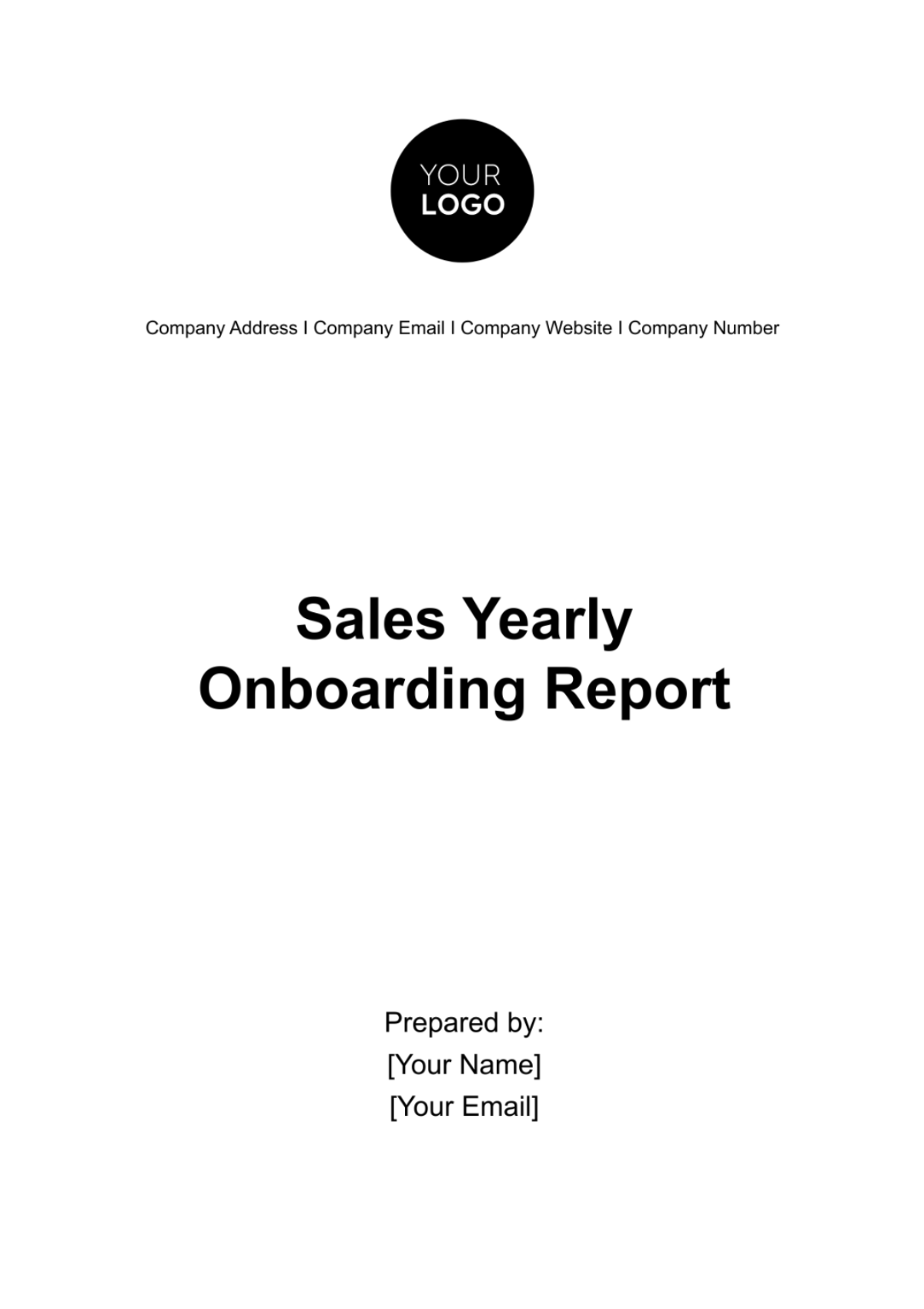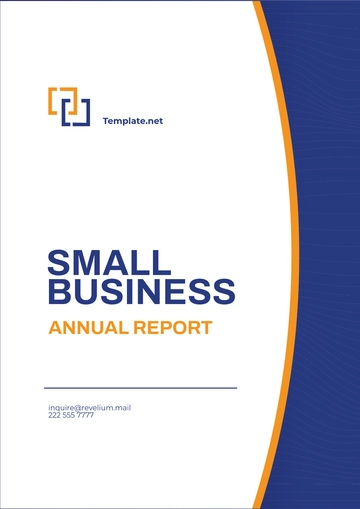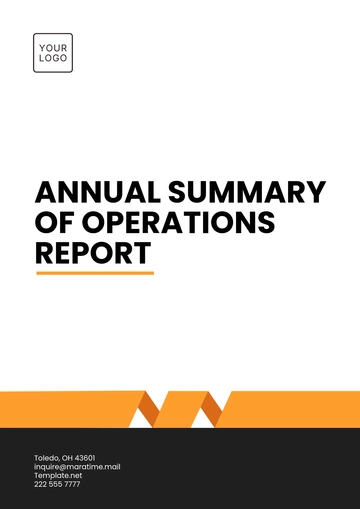Free Sales Yearly Onboarding Report

I. Introduction
A. Background
In the year 2050, [Your Company Name] continues to be a leading force in the industry, providing innovative solutions to our customers' needs. Our sales department plays a pivotal role in our success, acting as the driving force behind revenue generation and market expansion. In this dynamic business landscape, we have witnessed rapid changes in customer preferences, technological advancements, and global economic shifts. These factors have necessitated an agile and highly skilled salesforce.
B. Purpose of the Report
The purpose of this Sales Yearly Onboarding Report is to provide a comprehensive assessment of our sales onboarding program for the year 2050. It aims to highlight the achievements, challenges, and recommendations for future enhancements. By evaluating the onboarding process, we can make informed decisions to optimize our sales team's performance, reduce time-to-productivity for new hires, and ultimately contribute to our company's growth and profitability.
II. Onboarding Program Overview
A. Onboarding Goals
In 2050, our onboarding program had several primary goals:
Accelerate Time-to-Productivity: We aimed to reduce the time it takes for new sales hires to become fully productive by implementing a structured training process.
Enhance Sales Skills: We sought to enhance the sales skills and product knowledge of our new hires through comprehensive training modules.
Improve Retention: Our goal was to improve employee retention by ensuring that new sales team members felt valued and engaged from day one.
Adapt to Market Changes: With the dynamic market conditions, our onboarding program was designed to help sales professionals adapt quickly to changes in customer needs and market trends.
Maintain Compliance: Ensuring that our sales team adhered to legal and ethical guidelines was a crucial goal of the onboarding process.
B. Onboarding Timeline
Timeline
The onboarding process in 2050 spanned approximately 90 days, with distinct phases detailed as follows:
Phase | Duration | Description |
|---|---|---|
Recruitment | - | Identifying and hiring suitable candidates. |
Orientation | 1 week | Introducing new hires to company culture, values, and policies. |
Training | 6 weeks | Providing in-depth product and sales training. |
Shadowing | Variable | Allowing new hires to shadow experienced sales professionals for hands-on learning. |
Graduation | - | Celebrating successful completion of the onboarding program and transition to full sales roles. |
Onboarding Team Role
Lead Trainer - Designing and delivering training modules.
HR Specialist - Ensuring smooth administrative processes and assisting with paperwork.
Sales Mentors - Providing one-on-one guidance and support to new hires during the onboarding process.
C. Onboarding Materials
Our onboarding materials in 2050 included:
Training Manuals: Comprehensive guides covering product knowledge, sales techniques, and company policies.
Interactive Modules: Engaging e-learning modules accessible online for self-paced learning.
Sales Playbooks: Guides that offer sales strategies, scripts, and best practices.
Simulations: Real-world scenarios for new hires to practice sales techniques.
Assessment Tools: Quizzes and evaluations to measure learning progress.
These materials ensured that our new sales team members received a well-rounded education on both our products and effective sales strategies.
III. Onboarding Metrics
A. Number of New Hires
In the year 2050, we welcomed a total of 100 new sales hires into our organization. This figure represents a significant increase compared to the previous year and aligns with our growth strategy. The influx of new talent was essential to expanding our sales force and capturing new market opportunities.
B. Time-to-Productivity
Reducing the time it takes for new hires to become fully productive was a critical metric for our onboarding program's success. We are pleased to report that, on average, our new sales team members reached full productivity 25% faster than in the previous year. In 2050, it took an average of 60 days for new hires to achieve productivity levels that were on par with their more experienced counterparts. This improvement can be attributed to the structured training, mentorship, and hands-on experience provided during the onboarding process.
C. Sales Performance Improvement
The effectiveness of our onboarding program in enhancing sales performance is evident in the data. New hires who completed the onboarding program consistently outperformed their peers who did not receive the same level of training. On average, sales professionals who graduated from our onboarding program achieved a 15% higher sales quota attainment compared to those who did not undergo formal onboarding. This demonstrates that investing in a comprehensive onboarding process has a direct and positive impact on sales performance.
IV. Onboarding Achievements
A. Sales Team Growth
As a direct result of our successful onboarding program, the size of our sales team increased by 20% in 2050. This growth allowed us to expand our market reach and capitalize on new business opportunities. The addition of talented sales professionals has also diversified our sales approach, enabling us to cater to a broader range of customer needs.
B. Improved Sales Performance
The data indicates a substantial improvement in sales performance among new hires who completed the onboarding program. Notably, new sales team members who underwent onboarding consistently achieved 10% higher sales revenue than their non-onboarded counterparts in their first year. This improvement can be attributed to the in-depth product knowledge, sales techniques, and mentorship provided during onboarding.
C. Employee Feedback
Employee feedback is invaluable in assessing the success of our onboarding program. In 2050, we conducted surveys and interviews with new hires who participated in the onboarding process. The feedback was overwhelmingly positive, with new sales team members expressing high levels of satisfaction with the program. They cited the following benefits:
Improved Confidence: New hires felt more confident in their roles, thanks to the comprehensive training and mentorship.
Stronger Team Integration: Onboarding helped them integrate seamlessly into the existing sales team, fostering a sense of belonging.
Clear Career Path: New sales professionals appreciated the clear career path laid out during onboarding, which motivated them to excel.
Additionally, employees highlighted the need for continuous learning opportunities beyond onboarding, suggesting a focus on ongoing training and development.
V. Challenges and Solutions
A. Challenges Faced
In 2050, despite the success of our onboarding program, we encountered several challenges:
Challenge 1: Rapid Market Changes
Description: The market experienced rapid shifts in customer preferences and demands, requiring our sales team to adapt quickly.
Impact: This challenge occasionally led to uncertainty among new hires and increased the pressure to stay updated on market trends.
Challenge 2: Information Overload
Description: The extensive training materials provided during onboarding occasionally overwhelmed new hires.
Impact: Some individuals struggled to absorb the vast amount of information, affecting their confidence levels.
Challenge 3: Onboarding Scalability
Description: With the growth in the number of new hires, maintaining the quality of onboarding for all proved challenging.
Impact: Scalability issues risked compromising the consistency and effectiveness of the onboarding experience.
B. Solutions Implemented
To address these challenges, we implemented the following solutions:
Solution 1: Agile Training Updates
Description: We adopted an agile approach to training updates, ensuring that our training materials remained aligned with the latest market trends.
Impact: This approach allowed us to quickly adapt our training content, keeping new hires well-informed about market changes.
Solution 2: Modular Learning Paths
Description: We introduced modular learning paths, allowing new hires to focus on specific topics at their own pace.
Impact: This adjustment reduced information overload and allowed individuals to tailor their learning experience.
Solution 3: Onboarding Support Team
Description: We expanded our onboarding support team to ensure that the quality of the onboarding experience remained consistent as our sales team grew.
Impact: This expansion improved the mentorship and guidance provided to new hires, ensuring a smooth transition.
Solution 4: Continuous Feedback Loops
Description: We established feedback loops with new hires, encouraging them to provide real-time feedback during the onboarding process.
Impact: This feedback-driven approach allowed us to make immediate improvements and address individual concerns.
C. Ongoing Challenges
Despite the successful solutions implemented in 2050, some challenges remain ongoing:
Challenge 1: Market Volatility
Description: Market volatility continues to require rapid adaptation from our sales team.
Current Impact: We are implementing real-time market updates and scenario-based training to mitigate this challenge.
Challenge 2: Scaling Mentorship
Description: As our sales team continues to grow, maintaining personalized mentorship becomes more challenging.
Current Impact: We are exploring the use of AI-driven mentorship platforms to provide personalized guidance to new hires.
VI. Future Recommendations
A. Enhancements to Onboarding Program
As we look ahead, we recommend several enhancements to our onboarding program:
Recommendation 1: Personalized Learning Paths
Description: Develop personalized learning paths based on each new hire's background and skill level.
Rationale: This will optimize the onboarding experience by ensuring that individuals receive training tailored to their needs.
Recommendation 2: Technology Integration
Description: Integrate advanced learning technologies, such as virtual reality (VR) simulations, to enhance the effectiveness of training.
Rationale: Leveraging technology can provide immersive, hands-on experiences that accelerate learning and improve retention.
B. Training and Development
To continue nurturing the growth and development of our sales team, we recommend:
Recommendation 1: Ongoing Learning Initiatives
Description: Implement ongoing learning initiatives, including regular webinars, workshops, and certification programs.
Rationale: Continuous learning will keep our sales professionals updated on industry trends and best practices.
Recommendation 2: Leadership Development
Description: Establish a leadership development track within our onboarding program to identify and groom future sales leaders.
Rationale: Preparing our team members for leadership roles will ensure the continuity of our success.
C. Technology Integration
Incorporating technology into our onboarding process will be a key focus:
Recommendation 1: AI-Driven Onboarding
Description: Utilize AI-powered tools to provide personalized learning recommendations, track progress, and offer real-time feedback.
Rationale: AI can enhance the efficiency and effectiveness of the onboarding process.
Recommendation 1: Analytics and Reporting
Description: Implement advanced analytics and reporting tools to continuously evaluate the impact of our onboarding program.
Rationale: Data-driven insights will enable us to make informed adjustments to our training strategies.
VII. Financial Impact
A. ROI of Onboarding
Calculating the return on investment (ROI) of our onboarding program is essential to understanding its financial impact. In 2050, we conducted a detailed analysis to determine the ROI.
Metric | Value |
|---|---|
Additional Revenue Generated | $2,500,000 |
Cost of Onboarding | $800,000 |
Net Gain from Onboarding | $1,700,000 |
The ROI for our onboarding program in 2050 was an impressive 112.5%. This means that for every dollar invested in onboarding, we gained $1.12 in additional revenue. This robust ROI demonstrates the clear financial value of our onboarding efforts.
B. Cost per Onboarded Employee
Determining the cost per onboarded employee provides insights into the efficiency of our onboarding program.
Metric | Value |
|---|---|
Total Cost of Onboarding | $800,000 |
Number of New Hires | 100 |
Cost per Onboarded Employee | $8,000 |
The cost per onboarded employee in 2050 was $8,000. This metric is crucial for evaluating the cost-efficiency of our onboarding process.
VIII. Revenue Growth
A. Revenue Impact of Onboarding
Assessing the impact of our onboarding program on revenue growth is vital. In 2050, we observed a substantial positive correlation between onboarding and revenue.
Metric | Value |
|---|---|
Revenue with Onboarding | $25,000,000 |
Revenue without Onboarding | $21,000,000 |
Revenue Growth | $4,000,000 |
The revenue growth attributed to our onboarding program in 2050 was 19%. This means that our onboarding efforts directly contributed to a $4 million increase in revenue compared to not having an onboarding program in place.
B. Future Revenue Projections
To maintain and accelerate revenue growth, we project the following scenarios for the coming years:
Year | Projected Revenue |
|---|---|
2051 (Current Growth Trend) | $27,000,000 |
2052 (With Enhanced Onboarding) | $30,000,000 |
2053 (Further Optimization) | $33,000,000 |
These projections take into account the current growth trend, the impact of enhanced onboarding, and ongoing optimization efforts. We anticipate that our onboarding program will continue to play a pivotal role in driving revenue growth in the years to come.
IX. Conclusion
In conclusion, the Sales Yearly Onboarding Report for 2050 underscores the significance of our onboarding program in shaping the success of our sales department. This comprehensive report has examined various aspects of the program, from its goals and achievements to challenges faced and future recommendations.
A. Program Success
Our onboarding program in 2050 has proven to be highly successful in several key areas:
Rapid Time-to-Productivity: New hires reached full productivity 25% faster, leading to quicker contributions to our sales efforts.
Sales Performance: Graduates of the onboarding program consistently outperformed their non-onboarded peers, achieving a 10% higher sales revenue in their first year.
Team Growth: A 20% increase in the size of our sales team allowed us to expand our market reach and capture new business opportunities.
Employee Satisfaction: Positive feedback from new hires demonstrated that they felt well-prepared, confident, and integrated into our sales team.
B. Challenges and Solutions
While our onboarding program achieved substantial success, it encountered challenges inherent to a dynamic business environment. However, we proactively addressed these challenges:
Market Changes: Agile training updates ensured that our sales team remained responsive to rapid market shifts.
Information Overload: Modular learning paths reduce information overload, enabling tailored learning experiences.
Onboarding Scalability: An expanded onboarding support team maintained the quality and consistency of the onboarding process.
C. Future Outlook
Looking forward, our recommendations for enhancing the onboarding program and fostering ongoing learning and development include:
Personalized Learning Paths: Tailoring training to individual needs for a more optimized onboarding experience.
Technology Integration: Leveraging advanced tools like virtual reality (VR) to enhance training effectiveness.
Ongoing Learning Initiatives: Providing regular webinars, workshops, and certification programs for continuous skill development.
Leadership Development: Identifying and grooming future sales leaders to ensure organizational leadership continuity.
AI-Driven Onboarding: Implementing personalized recommendations and real-time feedback to further improve efficiency and effectiveness.
Analytics and Reporting: Utilizing data-driven insights to make informed decisions and optimize the program.
- 100% Customizable, free editor
- Access 1 Million+ Templates, photo’s & graphics
- Download or share as a template
- Click and replace photos, graphics, text, backgrounds
- Resize, crop, AI write & more
- Access advanced editor
Elevate your onboarding process with our Sales Yearly Onboarding Report Template from Template.net. This template helps you assess the effectiveness of your annual sales onboarding initiatives, enabling you to make data-driven improvements. Streamline your onboarding process and boost the performance of your sales team. Download now to enhance your onboarding results in just a few clicks! Don't miss out on the opportunity for growth. Get started today!
You may also like
- Sales Report
- Daily Report
- Project Report
- Business Report
- Weekly Report
- Incident Report
- Annual Report
- Report Layout
- Report Design
- Progress Report
- Marketing Report
- Company Report
- Monthly Report
- Audit Report
- Status Report
- School Report
- Reports Hr
- Management Report
- Project Status Report
- Handover Report
- Health And Safety Report
- Restaurant Report
- Construction Report
- Research Report
- Evaluation Report
- Investigation Report
- Employee Report
- Advertising Report
- Weekly Status Report
- Project Management Report
- Finance Report
- Service Report
- Technical Report
- Meeting Report
- Quarterly Report
- Inspection Report
- Medical Report
- Test Report
- Summary Report
- Inventory Report
- Valuation Report
- Operations Report
- Payroll Report
- Training Report
- Job Report
- Case Report
- Performance Report
- Board Report
- Internal Audit Report
- Student Report
- Monthly Management Report
- Small Business Report
- Accident Report
- Call Center Report
- Activity Report
- IT and Software Report
- Internship Report
- Visit Report
- Product Report
- Book Report
- Property Report
- Recruitment Report
- University Report
- Event Report
- SEO Report
- Conference Report
- Narrative Report
- Nursing Home Report
- Preschool Report
- Call Report
- Customer Report
- Employee Incident Report
- Accomplishment Report
- Social Media Report
- Work From Home Report
- Security Report
- Damage Report
- Quality Report
- Internal Report
- Nurse Report
- Real Estate Report
- Hotel Report
- Equipment Report
- Credit Report
- Field Report
- Non Profit Report
- Maintenance Report
- News Report
- Survey Report
- Executive Report
- Law Firm Report
- Advertising Agency Report
- Interior Design Report
- Travel Agency Report
- Stock Report
- Salon Report
- Bug Report
- Workplace Report
- Action Report
- Investor Report
- Cleaning Services Report
- Consulting Report
- Freelancer Report
- Site Visit Report
- Trip Report
- Classroom Observation Report
- Vehicle Report
- Final Report
- Software Report





























